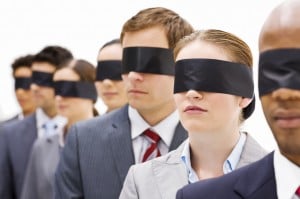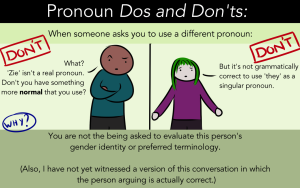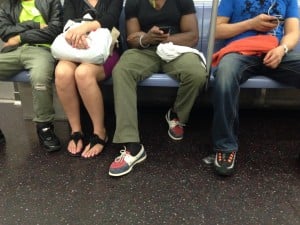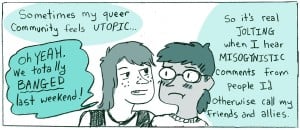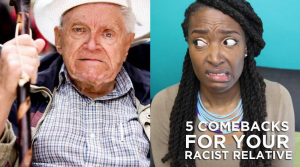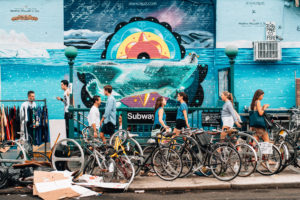
People walking in Williamsburg, New York.
Cold brews and fourteen-dollar raw juice joints and white folks everywhere; in what seems like a blink of an eye, your neighborhood has changed completely.
But, despite how abrupt it can feel, gentrification doesn’t happen overnight.
Gentrification happens after months, and sometimes even years, of preparation — crafted in the offices of real estate moguls and in the halls of city government.
New Orleans, Detroit, San Francisco, and New York have gentrified not because of the wishes of a million hipsters, but because of just a few hundred politicians, planners, and heads of corporations.
It’s difficult to understand when it begins and how it all plays out. Often, areas that are gentrified were neglected for so long by the majority of the city that it can seem to be a sudden awakening.
But when transportation provides access from these once-forgotten neighborhoods to areas with more investment, and the place becomes teeming with young, (mostly) white Millennials it becomes hard to ignore.
So, I wanted to break this process down in a way that clearly breaks down the big, overwhelming process of gentrification and how it happens. Check out the four stages below.
Stage 1: Hobbyists and People Priced Out of Their Community Scan For Tax Liens
The more public resources taken away from a community, the more profitable it is to gentrify.
For example, I’m a Gen Xer and my partner is a Baby Boomer and if we want to retire and own property there’s no way we can afford it in Los Angeles.
So we may move to the next, more affordable community over to buy property. It’s the revolving door of gentrification — we were pushed out of our community and will become gentrifiers in the next.
Every city has a map of tax-data, homes, and property that are being auctioned away due to outstanding taxes owed.
Punch in a zip code and you could pinpoint blocks that are the next communities to be gentrified, which usually means buildings are in disrepair (so they could be bought cheap) and it’s close to other gentrified areas (so it wouldn’t be too much of a stretch for gentrifiers to move in).
Stage 2: Local Governments Contract With A PR Firm
This concept of cities branding themselves began in the ‘80’s when Reagan cut funding for public housing and transportation. Those cuts forced cities to turn to alternative sources of funding, in particular bonds, to finance things such as public transit and road repair.
But not just anyone can issue a bond — governments first had to prove they’d be able to pay them back.
And there are only two entities that decide if a government or company is capable of paying back a bond: Standard & Poor’s and Moody’s rating agencies.
These entities would downgrade the rating of any government with high spending (basic social safety net) and not enough income (i.e. too many poor people).
To increase their credit ratings, cities were forced into becoming more entrepreneurial in a short period of time. They hired city managers and public relations teams in a quest to turn themselves into profitable entities — as if cities were corporations.
This remains very much a part of one of the first steps gentrification: when people from higher income neighborhoods and hobbyists begin buying up real estate. This is the phase when the media might write an article about how this neighborhood is the next hot new thing or even the “next Williamsburg.”
You may have seen these deplorable billboards that are posted throughout Detroit:

Detroit is 83 percent Black, but the new Detroit that gets all the attention in the press is overwhelmingly white, which brings us to…
Stage 3: Cities Contract With Developers To Tap Into That Gen Y Skrilla
Ever since the advertising agency Barkley put out a report that the direct spending power of millennials is expected to reach $200 billion, cities have been partnering with retail developers to bring in mixed-use projects.
Mayor of Somerville, Mass. negotiated with the Developer of Reality Investment Trust in Maryland to build Assembly Row, 2100 apartments and condos, 1.75 million square feet of office space, and 500,000 square feet of space dedicated to retail.
Before this, Assembly Square was the least developed area of the city. After the flight of manufacturing in Somerville, it was free of housing and cut off from the rest of the city.
This was by far one of the more affordable and diverse areas of the elite Eastern state housing for people who worked in property services and retail at one of the prestigious nearby colleges. Today the median age of residents living within a mile is 35 and within five miles it is 33.
Finally, with new revenue coming in, city mayors forge deeper relationships with developers, further privatizing public services. This privatization allocates public funding away from much-needed infrastructures such as transportation, education, and more.
For example, Dan Gilbert, a downtown Detroit investor and the guy who owns the development company that made the above billboard, developed a security force that patrols downtown Detroit and monitors more than 500 security cameras attached to Rock Venture’s buildings.
Gilbert’s security, along with a police force privately funded by Wayne University in Midtown, has become a police shadow agency, ensuring that low-level offenses in Detroit’s gentrified core remain at a minimum.
Wayne State, Detroit’s main university, has taken security one step further by certifying sixty officers with the state so that they can perform the same functions as real police. Now 60 percent of calls within Midtown are answered by Wayne State’s patrol.
The average response time in Midtown is ninety seconds. In the rest of Detroit, it can be up to an hour, even for deadly crimes. What does this say about how little we value poor and/or Black bodies of Detroit?
Stage 4: Neighborhoods Are Affordable Only To The Global Elite (#MissionGentrification Accomplished)
The results: buildings are no longer meant to house regular people and instead house millionaires and billionaires.
Nowhere is this phenomenon more apparent than in the Big Apple.
A New York Times investigation found that 50 percent of apartments are vacant for the majority of each year.
In other words, the fourth and last phase of gentrification goes beyond neighborhoods being more friendly to money than to people — they cease being places where one can live a normal life and become luxury commodities.
***
Perhaps the worst symptoms of all this planning are when the displaced individuals of gentrification see their old neighborhoods plastered on billboards and in advertisements — the message that’s touted: this place has value now.
A flipside to this is that many Americans still don’t accept the existence of extreme racism and extreme poverty in this country.
Usually, the idea that there are whole groups of people whose rights and lives are violated and threatened on a daily basis occurs to many Americans only in moments of national trauma.
For example, a few weeks after Hurricane Katrina, the lead story in the post-Katrina issue of Newsweek deemed New Orleans’ “forgotten” people “The Other America.”
Four days after Hurricane Katrina, Michael Brown, then-director of FEMA explained the disastrous emergency response by saying: “The American people don’t understand how fascinating and unusual this is—is that we’re seeing people that we didn’t know exist that suddenly are showing up on bridges or parts of the interstate that aren’t inundated.”
In order to curb gentrification and other types of systemic oppression, society must first recognize the humanity of those most deeply disenfranchised by these systems, otherwise, they might never be dismantled.
[do_widget id=’text-101′]
Melissa Chadburn is an Everyday Feminism Reporting Fellow. Melissa has written for Guernica, Buzzfeed, Poets & Writers, Salon, American Public Media’s Marketplace, Al Jazeera America and dozens of other places. She is a fellow for The Economic Hardship Reporting Project. Her essay, “The Throwaways,” received notable mention in Best American Essays and Best American Nonrequired Reading. Her debut novel, A Tiny Upward Shove, is forthcoming with Farrar, Straus, and Giroux.
Search our 3000+ articles!
Read our articles about:
Our online racial justice training
Used by hundreds of universities, non-profits, and businesses.
Click to learn more
Most Read Articles
- « Previous
- 1
- …
- 30
- 31
- 32










